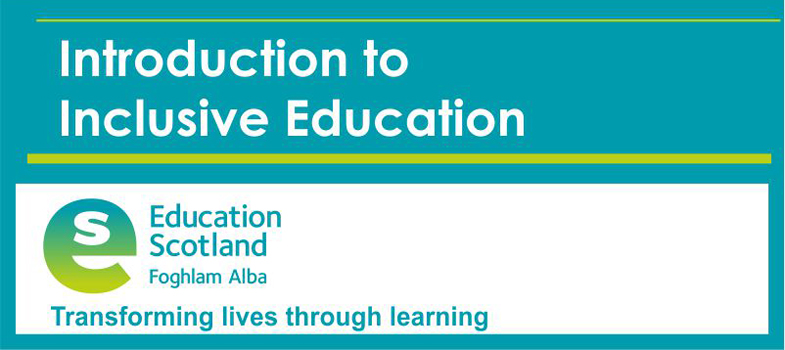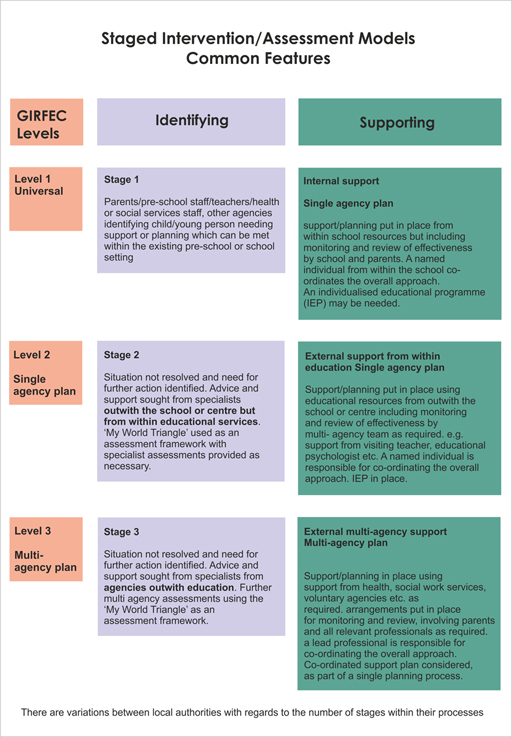4.2 Educational planning
All children and young people should have frequent and regular opportunities to discuss their learning and development with an adult who knows them well and with whom they have a mutually trusting relationship. This key member of staff has the holistic overview of the child or young person’s learning and personal development.
Staged intervention is used as a means of identification, assessment, planning,recording and review to meet the learning needs of children and young people.
All local authorities have a staged intervention and assessment process in place which enables practitioners to assess and meet learners’ needs. Staged intervention:
- Provides a solution-focused approach to meeting needs at the earliest opportunity and with the least intrusive level of intervention.
- Involves the child, parents/carers, school staff and, at some levels, other professionals all working in partnership to get it right for every child.
Staged intervention is designed to be flexible and allows for movement between stages depending on progress. The majority of learners will be supported within universal support and some learners will access more targeted support. Figure 14 provides an overview of universal and targeted support.
There are variations between local authorities regarding the number of stages within their process and their terminology used to describe planning documents. An overview using common terms is provided in the table below.
| Stages/levels | 1 | 2 | 3 |
| Examples of plans | Class planning Personal learning plan (PLP) | Individual Education Plan (IEP) | Coordinated Support Plan (CSP) Childs Plan |
Personal learning planning (PLP)
Personalised learning is at the heart of supporting learning in which the learning environment is a crucial factor. Conversations about learning, reviewing progress and planning next steps are central to this process. All children and young people should be involved in personal learning planning (PLP).The learner is provided with opportunities for achievement which focus on learning and progress made through activities across the full range of contexts and settings in which the curriculum is experienced. The 2017 Code of Practice says that children with additional support needs should be involved in their personal learning planning. It also says that, for many, this will be enough to meet their needs.
Individualised Educational Programme (IEP)
If a PLP does not enable sufficient planning, a child or young person’s PLP can be supported by an individualised educational programme (IEP). An IEP is a non-statutory document used to plan specific aspects of education for learners who need some of or their entire curriculum to be individualised. IEPs are usually provided when the curriculum planning required is to be ‘significantly’ different from the class curriculum. Involvement with group work or extraction for a number of sessions a week does not normally meet the criteria for an IEP.
Co ordinated Support Plan (CSP) – Targeted Support
A CSP is a statutory plan to help identification and ensure provision of services for children or young people, whose additional support needs arise from complex, or multiple factors, which have a significant adverse effect on their school education and are likely to last at least a year, and which require support to be provided by an education authority and at least one other non education service or agency. It is a legal document and aims to ensure that all the professionals, the child/young person and the parents/carers work together and are fully involved in the support
Child Plan – Targeted Support
In line with the 2014 Children and Young People Act and the ‘getting it right for every child’ approach, many children and young will now have a Child’s Plan. Child’s Plans are created if a child or young person needs some extra support to meet their wellbeing needs such as access to mental health services or respite care, or help from a range of different agencies. The Child’s Plan will contain information about:
- Why a child or young person needs support
- The type of support they will need
- How long they will need support and who should provide it.
All professionals working with the child would use the plan, which may include an IEP or a CSP. Where there is a Child’s Plan and targeted interventions to support a child or young person and parents, there will be a Lead Professional to co-ordinate that help.
Below are examples of targeted support which would require collaborative planning between partners.
Some children and young people will require additional support from agencies from outwith education services if they are to make progress. This support may be provided outwith an educational setting. Some examples are:
- Social work support to help a young person with social and emotional needs address their substance misuse
- A communication programme drawn up by a speech and language therapist and teacher for implementation in the classroom
- Promoting positive relationships programme delivered to a group of young people by staff from a voluntary agency
- Counselling provided by a voluntary agency for a child who has been bereaved and needs support to help overcome difficulties in school
- Psychiatric support for a child with mental health difficulties
- Specialist equipment support from physiotherapy
- A sensory integration programme provided by an occupational therapist
- Group or individual career support to engage choices for education, training or employment, in anticipating leaving school
Planning for flexible pathways
Curriculum for Excellence allows for a blended and flexible approach to learning, where schools and their partners now have much greater flexibility to offer a wider range of pathways and options, including vocational qualifications, in line with modern labour market demands and which meet the needs of every learner (Developing the Young Workforce).
Flexible pathway programmes can be planned and developed to meet the needs of learners identified as disengaged from formal education. It aims to provide an alternative learning structure for young people in line with their aspirations and interests in order to support the development of skills for learning, life and work and the progression pathways into positive destinations.
This approach can lead to:
- young people re-engaging with education
- improved attendance rates
- young people developing essential life and employability skills
- improvements in attitude, motivation, behaviour and skills development.
Flexible pathways may also be effective in supporting learners whose education has been interrupted.
4.1 The inclusive learning environment

